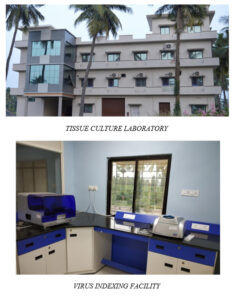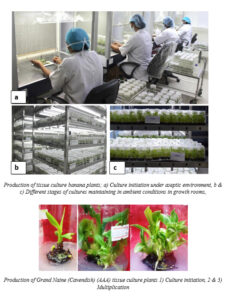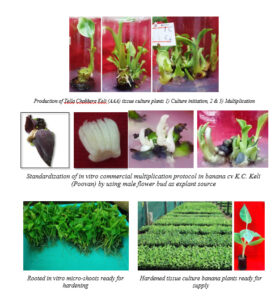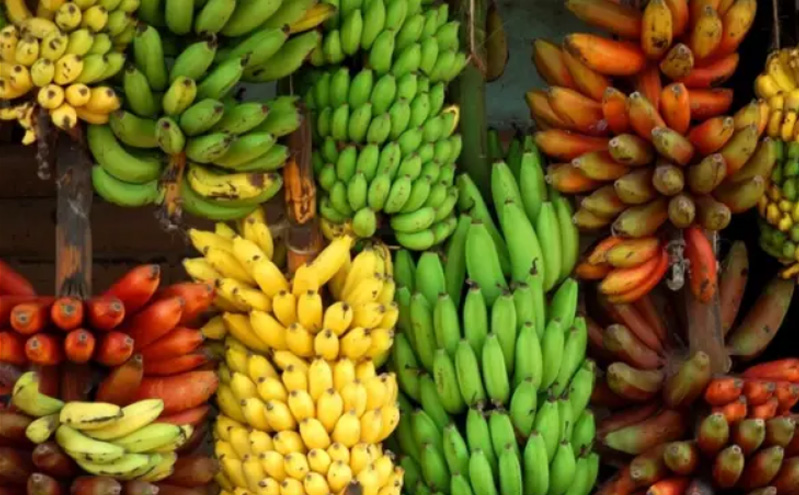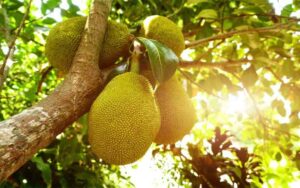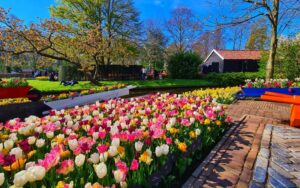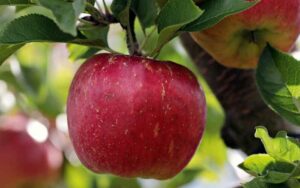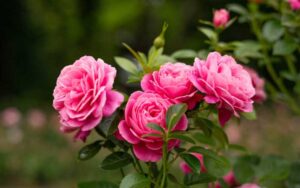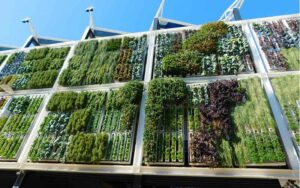Micro-propagation Protocols for Native Banana Cultivars of Andhra Pradesh
K. Ravindra Kumar1, A. Snehalatha Rani2 and R. V. S. K. Reddy
- Senior Scientist (Hort.), Horticultural Research Station, Kovvur
- Scientist (Pl. Path.), Horticultural Research Station, Kovvur
- Director of Research DrYSRHU, Venkataramannagudem,
In India, Andhra Pradesh stands third in area under banana after Karnataka and Kerala, first in production and fourth in productivity after Madhya Pradesh, Gujarat and Punjab. It is grown in an area of 89,000 ha with a production of 5003 thousand metric tons. Banana enjoys second position after mango among fruit crops in the state. In Andhra Pradesh, Kadapa (16370ha) ranks first in area followed by West Godavari (13760 ha), East Godavari (13,380 ha), Anantpur (12,330 ha) and Vizianagaram (11,080 ha) districts. Especially in coastal zone of Andhra Pradesh polyclonal banana cultivation is prevailing and substantial area is occupied with native banana cultivars like Tella Chakkera Keli (AAA), Erra Chakkera Keli (AAA), Karpura Chakkera Keli (AAB), Martaman (AAA), Godavari Bontha (ABB) and Kovvurbontha (ABB). During the year 2016-17, 110872 MT of banana fruits worth of Rs. 388 cores were exported to different countries and there is a good scope for exporting the traditional banana varieties like Karpura Chakkera Keli (Poovan) and Erra Chakkera Keli genotypes. Despite frequent natural calamities like cyclones, extreme summer temperatures, gales, hail storms, etc., the area under banana is increasing year after year indicating the economic importance of the crop in the state.
With the increase in area under cultivation of banana, there is a huge demand for uniform, quality and disease free quality planting material (QPM). In the light of severe spreading of the viral and bacterial diseases during recent times the responsibility has further increased as there is an utmost need to increase the production and supply of disease free planting material as per the demand which is raising day by day from the potential banana growing districts in the state. The area expansion has, however, been accompanied by rampant spread of pests and diseases, most important among which are viral diseases transmitted through non-indexed planting material. Thus, the need for production of disease free, quality planting material is being felt more than ever before not only in the state but in other regions as well. Most of the banana gardens are infested with BBrMV (Banana bract mosaic virus), CMV (Cucumber mosaic virus) and BBTV (Banana bunchy top virus). These virus diseases are spreading rampantly in traditional banana growing areas by using disease infested suckers as planting material. Moreover, some of the traditional varieties like Tella Chakkera Keli, Mortaman and Bontha cultivars are highly susceptible to banana bacterial rhizome rot caused by Erwinia carotovora. Regular and continuous use of sword suckers as planting material resulting in reducing net yields of these traditional varieties apart from spreading more pest and diseases.All these problems can be mitigated by the large commercial scale production of tissue culture plant material. Production of planting material through virus indexing of mother plants is the only option for checking the spread of these diseases and for in vitro production and distribution of the disease free planting material.
The earliest reports of in vitro culture of bananas came from Taiwan in the 1970’s by using shoot tips or apical meristems as explants. Till date, protocols have been standardized for in vitro propagation of a wide range of Musa species and cultivars belonging to various ploidies and genomes. Shoot tips can be extracted from the pseudostem, suckers, peepers, lateral buds or even small eyes which contain a shoot meristem. Though all of them behave similarly under in vitro conditions, sword suckers are preferred because of their ease of handling and the minimum damage caused to the parent plant during their removal. It is always better to collect the explants from flowering plants so as to ascertain their trueness to type.
Advantages of tissue culture banana plants over conventional sword suckers as planting material:
- Rapid multiplication: The rate of multiplication in banana is very low and restricted to 5-20 suckers per plant in different genotypes during its growth period, which makes it difficult to obtain sufficient amount of planting material of a clone of choice. It is a major impediment for largescale field reach of newly released varieties. Thus, standardization of protocols facilitates production of large number of plantlets/unit time, thus helping in rapid introduction and dissemination of new varieties.
- Requirement of limited mother stock: The rapid multiplication technology ensures that limited number of mother plants are required for raising large number of quality planting material (QPM). These few mother plants can be maintained with required care at a limited cost
- Uniformity: Micro-propagation results in a high degree of genotypic and phenotypic uniformity of the progeny plants.
- Season independent production: In conventionalpropagation through suckers, the availability of planting material is highly dependent on the cropping season of a particular area and, hence, availability of planting material in a given season is often a limiting factor. The planting season in most of the banana production areas starts with the onset of monsoon, which creates a heavy demand for the planting material often leading to supply of substandard material. Using micropropagation, the production of planting material can be achieved as per needs.
- Agronomic advantages: Micro-propagated plants exhibit uniform growth and maturity enabling one time harvesting. The once over harvest provides a gain of 60-70 days which allows the farmers to raise a short duration crop that adds to the income and soil fertility. It also saves on labour and energy for transportation which are the major concerns of the growers.
- Production of disease free planting material using tissue culture: It is possible to develop planting material which is free from sucker borne diseases, nematodes and pests. Use of healthy planting material complemented with integrated pest management program is the key to a good crop stand in field.
- Exchange of material: Helpful for easy exchange of germplasm planting material across the laboratories.
- High returns: Since the micro-propagation based progeny is genotypically and phenotypically similar to the mother plant, which is often a superior selection, the yield and returns are expectedly higher.
Maintenance of mother nursery block and selection of mother plants:
- Mother plant should be healthy, true to type and free from diseases and pests, especially virus diseases.
- The male flowers buds should be retained to check the presence of virus diseases (male flower buds exhibit symptoms of late infection of viruses like BBTV and BBrMV).
- Mother plants should be raised under roofless insect proof shade net with sufficient height.
- Mother nursery must be located away from other banana plantations with an isolation distance of 500 m to maintain purity and to avoid spread of virus diseases.
- Mother plants should be grown under very good management conditions so as to facilitate the true expression of traits.
- Individual plants should be tagged with a master code number so that the plantlets developed could be traced back to the mother plant.
- Pedigree record and source of each mother plant should be maintained and catalogued.
Once indexed, the mother suckers can be maintained in field or concrete rings with frequent decapitation to facilitate production of more axillary buds which will also serve as explants for culture initiation.
The following are the some of the important steps standardized for production of micropropagation based native banana planting material:
- Selection of mother plant and establishment of mother block nursery,
- Virus indexing of mother plant nursery,
- Culture initiation by using apical meristems in I0, I1, I2 and M1 Cycles,
- Culture proliferation from C1 to C7 cycles,
- Rouging at various stages of proliferation,
- Rooting,
- Primary and Secondary hardening accompanied by rouging,
- Fidelity testing and virus indexing at various stages of mass multiplication.
Horticulture Research Station, Kovvur under the aegis is the prime institute responsible for the production of virus free planting material of several commercial and traditional banana cultivars in the state of Andhra Pradesh. The tissue culture protocols for Tella Chakkera Keli, Karpura Chakkera Keli, Erra Chakkera Keli, Kovvur Bontha and Godavari Bontha are well standardized and involved in the production of planting material on commercial scale.
Standardized protocols available at Dr.YSRHU – HRS – Kovvur:
- Standardized the tissue culture protocols for banana cultivars viz., Grand Naine (AAA), Dwarf Cavendish (AAA) Tellachakkerakeli (AAA), Red Banana (AAA)and Karpura Chakkera Keli (AAB)for the commercial multiplication. By using these optimized protocols, nearly 1.5 to 2.0 lakh in vitro plants are being multiplying at HRS, Kovvur and suppled to farmers.
- For the first time, standardized the protocol for culinary banana cultivars like, Kovvurbontha (ABB) and Godavari Bontha (ABB) and produced nearly 20,000 tissue culture plants during the year 2019-20. Efforts are being made to produce largescale multiplication of these plantain group.
Development of protocols for other banana varieties:
- There is a huge demand for the requirement of tissue culture plants of Karpura Chakkera Keli (AAB) owing to its beneficial characters like virus free plant material, quality produce and precocious bearing. The existing standardized protocols are not useful for the multiplication of these genotypes owing to poor initial establishment, higher phenolic exudation, higher endogenous bacterial contamination, slow rate of multiplication, poor plant growth and undesirable rooting. To address these constraints experiments are conducting for efficient commercial multiplication by using shoot tip culture.
- Also standardizing the tissue culture protocols for commercial multiplication of banana cv. Karpurachakkerakeli (AAB) by using male flower buds. Standardized different culture media for cauliflower like body induction, multiplication and shoot induction by modifying different growth regulator combinations. Genetic fidelity studies conducted with 10 IISR and 10 SSR markers revealed that, these regenerated shoots are genetically stable with its mother plant. At present these male flower bud originated plants are being evaluated in field along with tissue culture Karpura Chakkera Keli plants developed from apical meristem explants for confirmation at field level genetic stability for all the growth and yield characters. It was also noticed that the plant material is precocious by 2 months which can be claimed as a climate resilient technology suitable for huge scale commercial multiplication in an otherwise long duration traditional variety.
